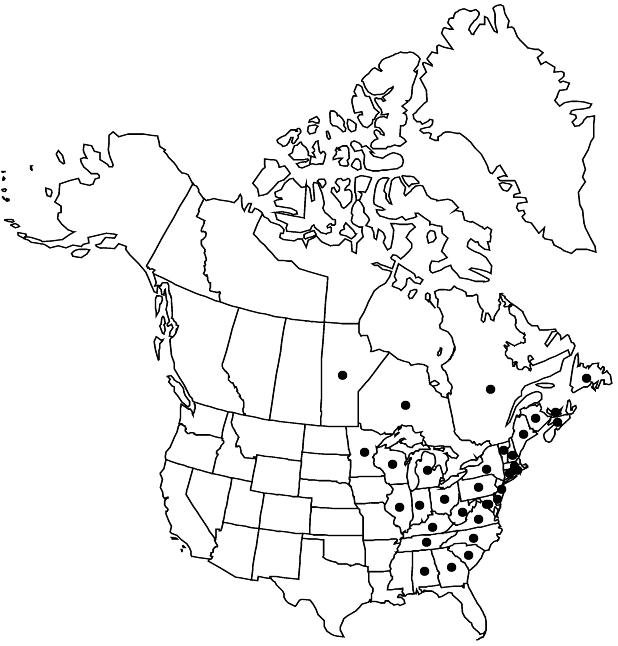Gaultheria procumbens
Sp. Pl. 1: 395. 1753 ,.
Subshrubs, creeping, not mat-forming, rhizomatous or stoloniferous; adventitious roots absent. Stems decumbent, branches ascending, 5–20 cm, lanate, glabrescent. Leaf blades (pale green abaxially, bright green, glaucous adaxially), obovate to oval or orbiculate, 1.5–4.5 cm, base cuneate to rounded, margins serrate (teeth bristle-tipped), (slightly revolute), apex acute to rounded or obtuse, rarely mucronate, surfaces sparsely hairy (hairs unbranched). Inflorescences axillary, solitary flowers or with 2–3 nodding flowers per node; bracts reddish, cordate, distinctly concave, 1–2 mm, not exceeding sepals, ciliate marginally. Pedicels pinkish, 1–3 mm, lanate; bracteoles absent. Flowers: sepals 5, connate 1/2 to nearly their entire lengths, white, cordate, 2.5–3.5 mm, ciliate marginally; petals 5, connate nearly their entire lengths, white, 8–10 mm, adaxial surface lanate-hairy, corolla urceolate, lobes 1 mm; filaments (pinkish), slightly widened proximally, lanate-tomentose; anthers with 2 apical awns (awns not bifurcating), dehiscent by subterminal pores proximal to awns. Fruits bright red to reddish violet, 6–9 mm wide. 2n = 44, 88.
Phenology: Flowering Jun–Sep; fruiting Sep–Jan.
Habitat: Mixed woodlands, mesic forests, dry, acidic woodlands, powerline rights-of-way, roadbanks, old pastures, coniferous woodlands, maritime heathlands, montane heath balds, bogs and fens, usually in acidic and/or sandy soils
Elevation: 0-1500 m
Distribution

Man., N.B., Nfld. and Labr. (Nfld.), N.S., Ont., P.E.I., Que., Ala., Conn., Del., D.C., Ga., Ill., Ind., Ky., Maine, Md., Mass., Mich., Minn., N.H., N.J., N.Y., N.C., Ohio, Pa., R.I., S.C., Tenn., Vt., Va., W.Va., Wis.
Discussion
Although common or abundant in most of its range, Gaultheria procumbens has been listed as endangered in Illinois.
Selected References
None.